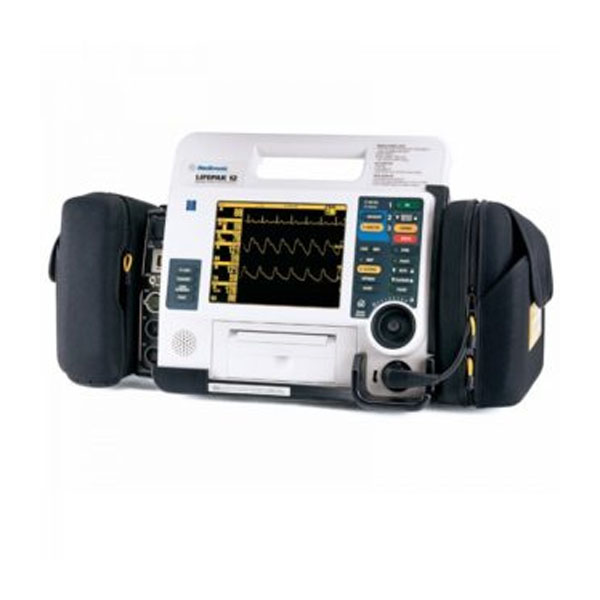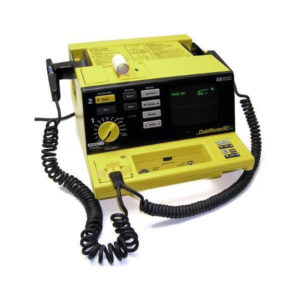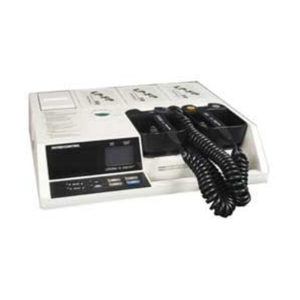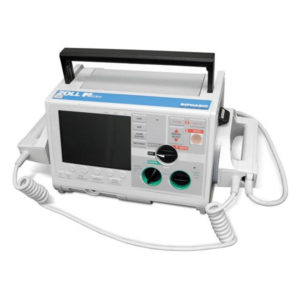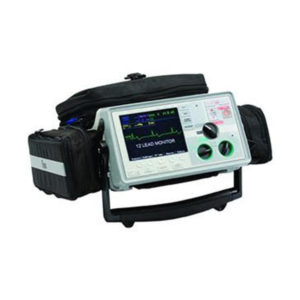Description
Physical
- Weight
- Lifepak 12 Basic defibrillator/monitor with QUIK-COMBO cable: 6.6 kg (14.5 lbs) (unit and QUIK-COMBO cable only – no batteries)
- Fully featured defibrillator/monitor with QUIK-COMBO cable: 8.0 kg (17.6 lbs) (unit and QUIK-COMBO cable only – no batteries)
- Lifepak 12 FASTPAK battery: 0.64 kg (1.4 lbs)
- Lifepak 12 FASTPAK 2 battery: 0.64 kg (1.4 lbs)
- LIFEPAK NiCd battery: 0.8 kg (1.7 lbs)
- LIFEPAK SLA battery: 1.27 kg (2.8 lbs)
- Height: 31.7 cm (12.5 in)
- Width: 38.9 cm (15.3 in)
- Depth: 21.7 cm (8.5 in)
Display
- Size
- 140.8 mm (5.5 in) wide x 105.6 mm (4.2 in) high for LCD, or
- 165.1 mm (6.5 in) wide x 123.8 mm (4.9 in) high for EL display
- Display Type
- 640 dot x 480 dot black and white LCD or amber and black EL display
- User selectable display contrast on the Lifepak 12
- Displays a minimum of 4 seconds of ECG and alphanumerics for values, device instructions, or prompts.
- Option to display one or two additional waveforms on the Lifepak 12
- Waveform display sweep speed: 25 mm/sec for ECG, SpO2, IP, and 12.5 mm/sec for CO2
Communications
- The Lifepak 12 is capable of transferring data records by PC Card internal modem, external EIA/TIA modem, cellular modem, or serial connection.
- Supports EIA/TIA-602 compatible modems using Xon/Xoff or RTS/ CTS flow control at 9600-38400 bps.
- EIA/TIA-232E compatible at 9600, 19200, 38400, 57600 bps.
- Group III, Class 2 or 2.0 facsimile, (wired only).
Operating Modes
- Advisory Mode (SAS:) Provides all features available except manual defibrillation, synchronous cardioversion, pacing, and access to previous patient records on the Lifepak 12
- Manual Mode: Provides normal operating capability for ALS users.
- Archive Mode: Allows operator to transmit, print, edit, or delete previous patient records.
- Setup Mode: Allows operator to configure the Lifepak 12.
- Service Mode: Allows operator to execute device diagnostic tests and calibrations on the Lifepak 12.
- Inservice Mode: Provides simulated waveforms and trend graphs for demonstration purposes.
Power
- Battery Only Configuration
- Choice of NiCd (FASTPAK or FASTPAK 2 battery, NiCd battery 1.7 Ah or 2.4 Ah3) or SLA (LIFEPAK SLA battery)
- Dual battery capability
- Optional external AC Power Adapter
- Batteries charge while device operates from Power Adapter
Data Management
- The device captures and stores patient data, events (including waveforms and annotations), and continuous ECG waveform records in internal memory.
- The user can select and print reports and transfer the stored information via an internal modem and various serial transfer protocols.
- Report Types
- Three format types of CODE SUMMARY critical event record (short, medium, and long)
- •Initial ECG (except short format)
- •Auto vital sign measurements every 5 minutes
- 3-channel or 4-channel 12-lead ECG report
- Continuous ECG waveform records (transfer only)
- Trend Summary
- Vital Signs Summary
- Snapshot
- Three format types of CODE SUMMARY critical event record (short, medium, and long)
ECG Monitor
- ECG on the Lifepak 12 is monitored via several cable arrangements. A 3-wire cable is used for 3-lead ECG monitoring. A 5-wire cable is used for 7-lead ECG monitoring. A 10-wire cable is used for 12-lead acquisition. When the chest electrodes are removed, the 10-wire cable functions as a 4-wire cable. Standard paddles or QUIK-COMBO pacing / defibrillation / ECG electrodes or FAST-PATCH disposable defibrillation / ECG electrodes are used for paddles lead monitoring.
- Lead Selection
- Leads I, II, III, (3-wire ECG cable)
- Leads I, II, III, AVR, AVL, and AVF acquired simultaneously, (4-wire ECG cable)
- Leads I, II, III, AVR, AVL, AVF, and C-lead acquired simultaneously, (5-wire ECG cable)
- Leads I, II, III, AVR, AVL, AVF, V1, V2, V3, V4, V5, and V6 acquired simultaneously, (10-wire ECG cable)
- EGG Size: 4, 3, 2.5, 2, 1.5, 1, 0.5, 0.25 cm/mV (fixed at 1 cm/mV for 12-lead)
- Heart Rate Display on the Lifepak 12
- 20–300 bpm digital display
- Accuracy: ±4% or ±3 bpm, whichever is greater
- Out of range indication: Display symbol “—”
- Heart symbol flashes for each QRS detection
- QRS Detection Range
- Duration: 40 to 120 ms
- Amplitude: 0.5 to 5.0 mV
- Continuous Patient Surveillance System (CPSS)
- In advisory mode, while Shock Advisory System is not active, CPSS monitors the patient, via QUIK-COMBO paddles or Lead II ECG, for potentially shockable rhythms.
- Voice Prompts: Used for selected warnings and alarms (configurable on/off).
- Analog ECG Output: 1V/mV x 1.0 gain
- Common Mode Rejection: 90 dB at 50/60 Hz
SpO2 (Masimo Sensors)
- Saturation Range: 1 to 100%
- Saturation Accuracy
- Adults/Pediatrics: ±2 digits (during no motion conditions); ±3 digits (during motion conditions)
- Neonates
- ±3 digits (during no motion conditions); ±3 digits (during motion conditions)
- Dynamic signal strength bar graph
- Pulse tone at the onset of the pleth waveform
- SpO2 Update Averaging Rate on the: User selectable 4, 8, 12 or 16 seconds
- SpO2 measurement on the: Functional SpO2 values are displayed and stored
- Pulse rate range: 25 to 240 pulses per minute
- Pulse Rate Accuracy
- Adults / Pediatrics / Neonates: ±3 digits (during no motion conditions); ±5 digits (during motion conditions)
- SpO2 waveform with autogain control
- Nellcor sensors when used with MNC-1 adapter
NIBP
- Blood Pressure on the
- Systolic Pressure range: 30 to 245 mmHg (4 to 32.7 kPa)
- diastolic Pressure range: 12 to 210 mmHg (1.6 to 28 kPa)
- Mean Arterial Pressure range on the: 20 to 225 mmHg (2.7 to 30 kPa)
- Units: mmHg, kPa, (user configurable)
- Blood Pressure Accuracy on the: maximum mean error of ±5 mmHg
- (±0.7 kPa) with a standard deviation no greater than ±8 mmHg
- (±1.1 kPa)
- blood pressure measurement: 40 seconds, typical
- Pulse Rate
- Pulse Rate range: 30 to 200 pulses per minute
- Pulse Rate accuracy: ±2 pulses per minute or ±2%, whichever is greater
- Operation Features
- Initial Cuff Pressure on the: User selectable, 100 to 180 mmHg
- Automatic Measurement Time Interval: User selectable
- Automatic Cuff Deflation
- Excessive Pressure: If cuff pressure exceeds 300 mmHg
- Excessive Time on the: If measurement time exceeds 120 seconds
CO2 on the
- CO2 Range: 0 to 99 mmHg (0 to 13.2 kPa); Units: mmHg, kPa, % (user configurable)
- CO2 Accuracy (0 to 20 minutes): 0 to 38 mmHg (0 to 5.1 kPa): ±4 mmHg; 39 to 99 mmHg (5.2 to 13.2 kPa): ±12% of reading
- CO2 Accuracy (>20 minutes): 0 to 38 mmHg (0 to 5.1 kPa): ±2 mmHg; 39 to 99 mmHg (5.2 to 13.2 kPa): ±5% of reading; +0.08% for every 1 mmHg (0.13 kPa) above 38 mmHg
- Respiration Rate Range on the: 0 to 60 breaths/minute
- Respiration Rate Accuracy: 0 to 40 bpm: ±1 bpm; 41 to 60 bpm: ±2 bpm
- Warm up time: 30 seconds (typical), 180 seconds maximum
- Rise Time: 190 ms
- Response Time: 2.9 seconds (includes delay time and rise time)
- Ambient Pressure on the: Automatically compensated internally
- Optional Display Waveform on the: CO2 Pressure
IP
- Transducer Type: Strain-gauge resistive bridge
- Transducer Sensitivity: 5μV/V/mmHg
- Excitation Voltage on the: 5Vdc
- Connector: Electro Shield CXS 3102A 14S-6S
- Bandwidth: Digital filtered, dc to 30 Hz (< -3db)
- Zero Drift: 1 mmHg/hr without transducer drift
- Zero Adjustment: ±150 mmHg including transducer offset
- Numeric Accuracy: ±1 mmHg or 2% of reading, whichever is greater, plus transducer error
- Range: -30 to 300 mmHg in six user selectable settings
- Pulse Range: Pulse rate not derived from IP, IP monitor functions over the full ECG/SpO2/NIBP HR/PR range of 20–300 bpm
- Leakage Current: Meets ANSI/AAMI/IEC leakage requirements
- IP Connector Pinout: Counterclockwise from 12 o’clock, viewed from the front of the Lifepak 12:
- A pin = -signal; B pin = +excitation; C pin = +signal;
- D pin = -excitation; E pin = shield; F pin = unlabeled.
- Invasive Pressure Display
- Display: IP waveform and numerics
- Units: mmHg, kPa (user configurable)
- Labels: P1 or P2, ART, PA, CVP, ICP, LAP (user selectable)
Trend
- Display: Choice of HR, SpO2 (%), EtC02, FiCO2, RR, NIBP, P1, P2, STM shown in Channels 2 or 3
- Time Scale: Auto, 30 minutes, 1, 2, 4, or 8 hours
- Duration: Up to 8 hours with -06 or later Memory PCB. Reduced storage capacity with earlier versions of the.
ST
- After initial 12-lead ECG analysis it automatically selects and trends ECG lead with the greatest ST displacement
Alarms
- Quick Set: Activates alarms for all parameters
- VF/VT Alarm: Activates continuous CPSS monitoring in Manual Mode
- Apnea Alarm: Occurs when 30 seconds has elapsed since last detected respiration
- Heart Rate Alarm Limit Range: Upper, 100–250 bpm; lower, 30–150 bpm
Interpretive Algorithms
- 12-Lead Interpretive Algorithm: GE Medical 12SL, includes AMI statements
Printer
- Prints continuous strip of the displayed patient information
- Paper Size: 50 mm (2.0 in) or optional 100 mm (3.9 in)
- Print Speed: 25 mm/Sec ±5% (measured in accordance with AAMI EC-11, 4.2.5.2) Optional 50 mm/sec time base for 12-Lead ECG reports
- Delay: 8 seconds
- Autoprint: Waveform events print automatically (user-configurable)
Frequency Response
- Diagnostic Frequency Response: 0.05 to 150 Hz or 0.05 to 40 Hz (user-configurable)
- Monitor Frequency Response: 0.67 to 40 Hz or 1 to 30 Hz (user-configurable)
- Paddles Frequency Response: 2.5 to 30 Hz
- Analog ECG Output Frequency Response: 0.67 to 32 Hz (except 2.5 to 25 Hz for Paddles ECG and 1.3 to 23 Hz for 1 to 30 Hz Monitor Frequency Response)





